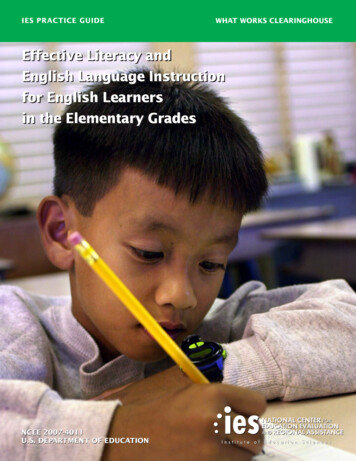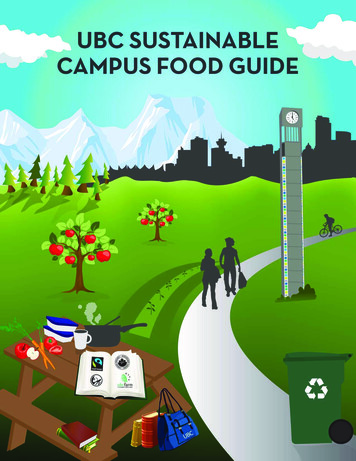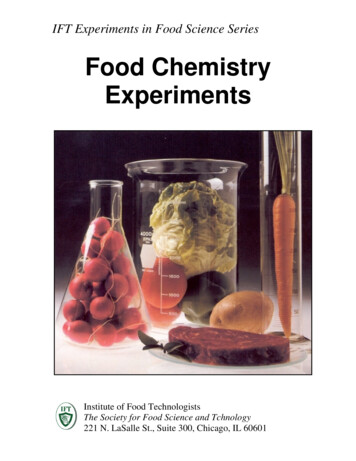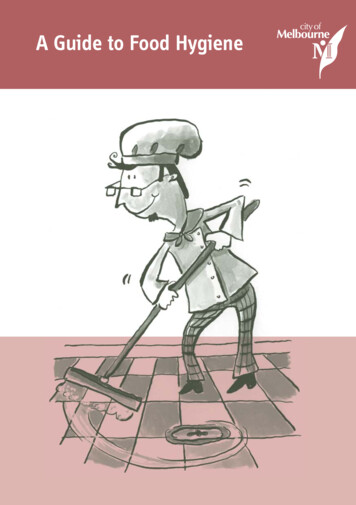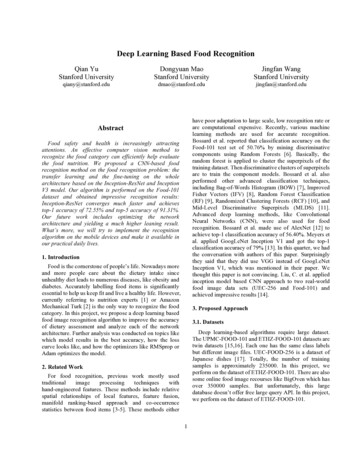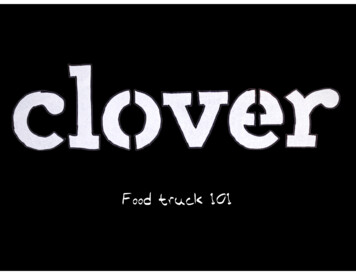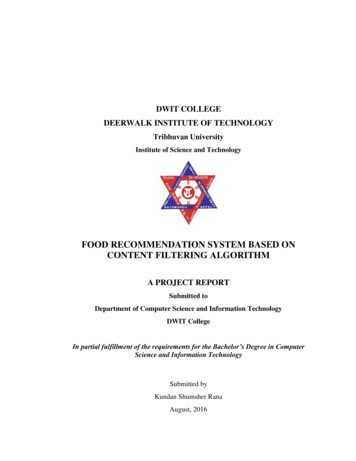
Transcription
DWIT COLLEGEDEERWALK INSTITUTE OF TECHNOLOGYTribhuvan UniversityInstitute of Science and TechnologyFOOD RECOMMENDATION SYSTEM BASED ONCONTENT FILTERING ALGORITHMA PROJECT REPORTSubmitted toDepartment of Computer Science and Information TechnologyDWIT CollegeIn partial fulfillment of the requirements for the Bachelor’s Degree in ComputerScience and Information TechnologySubmitted byKundan Shumsher RanaAugust, 2016
DWIT CollegeDEERWALK INSTITUTE OF TECHNOLOGYTribhuvan UniversitySUPERVISOR’S RECOMENDATIONI hereby recommend that this project prepared under my supervision by KUNDANSHUMSHER RANA entitled “FOOD RECOMMENDATION SYSTEM BASED ONCONTENT FILTERING ALGORITHM” in partial fulfillment of the requirements forthe degree of B.Sc. in Computer Science and Information Technology be processed for theevaluation. Rituraj LamsalLecturerDeerwalk Institute of TechnologyDWIT College
DWIT CollegeDEERWALK INSTITUTE OF TECHNOLOGYTribhuvan UniversityLETTER OF APPROVALThis is to certify that this project prepared by KUNDAN SHUMSHER RANA entitled“FOOD RECOMMENDATION SYSTEM USING CONTENT BASED FILTERING” inpartial fulfillment of the requirements for the degree of B.Sc. in Computer Science andInformation Technology has been well studied. In our opinion it is satisfactory in the scopeand quality as a project for the required degree. Rituraj Lamsal [Supervisor]LecturerDWIT College Hitesh KarkiChief Academic OfficerDWIT College .Jagdish Bhatta [External Examiner]IOST, Tribhuvan University .Sarbin Sayami [Internal Examiner]Assistant ProfessorIOST, Tribhuvan Universityi
ACKNOWLEDGEMENTI am grateful to my respected supervisor Mr. Ritu Raj Lamsal for his valuable guidance.His encouragement has been a great support for me to complete this work. His usefulsuggestions have been vital and all of his assistance has been sincerely acknowledged.I would also like to extend my appreciation to Mr Sarbin Sayami for helping me throughthis project.I would like to appreciate Mr. Hitesh Karki, for giving me this opportunity to undertakethis project. I thank him for his whole hearted support and enthusiasm.At the end, I would like to express my sincere thanks to all my friends and others whohelped me directly or indirectly during this project work.Kundan Shumsher RanaTU Exam Roll no: 1803/069ii
STUDENT’S DECLARATIONI hereby declare that I am the only author of this work and that no sources other than thelisted here have been used in this work. . . . . . . .Kundan Shumsher RanaDate:iii
ABSTRACTThe project entitled “Food Recommendation System based on Content Based FilteringAlgorithm” recommends a food item list and displays the result depending on thenutritional value of the food item. Here, a primary food ingredients is selected. If the fooditems that are in the database have either ingredient as a main ingredient, then the fooditems are listed in order of their nutritional value. (WHO, 2010.)The project analyzes the food items in database and their main ingredients. When theingredient that the user queried about is found, in the database of the food items present,they are sorted and filtered according to the nutritional value they contain. The amount ofcalorie that the food contains is taken into consideration here. The suggestion to the user isbased on the amount of calories present in the food item. The recommendation is donebased on Content Based Filtering Algorithm.Keywords: Food Recommendation, Nutrition, Nutritional Value in Food, Content BasedFiltering Algorithmiv
TABLE OF CONTENTSLETTER OF APPROVAL . iACKNOWLEDGEMENT . iiSTUDENT’S DECLARATION . iiiABSTRACT . ivLIST OF FIGURES . viiiCHAPTER 1: INTRODUCTION . 11.1Background . 11.2Objectives . 21.3Scope . 21.4Limitation . 21.5Report Outline . 3CHAPTER 2: REQUIREMENT AND FEASIBILITY ANALYSIS . 42.1 Literature Review. 42.1.1 Content based filtering algorithm . 52.1.2 Limitations of content based filtering algorithm . 52.1.3 Related works. 62.2 Requirement Analysis . 7v
2.2.1 Functional requirement . 72.2.2 Non-functional requirement . 72.3 Feasibility Analysis . 82.3.1 Operational feasibility. 82.3.2 Technical feasibility . 92.3.3 Schedule feasibility . 9CHAPTER 3: SYSTEM DEVELOPMENT . 103.1 Methodology and Algorithm. 103.1.1. Data collection . 103.1.2 Data processing . 103.1.3 Algorithm used. 113.2 System Analysis . 113.2.1 Sequence diagram . 123.2.2 State diagram . 13CHAPTER 4: IMPLEMENTATION AND TESTING . 144.1 Implementation . 144.1.1 Tools used . 144.2 Testing. 144.2.1 Unit testing . 14CHAPTER 5: MAINTENANCE . 16vi
5.1 Corrective Maintenance . 165.2 Adaptive Maintenance . 16CHAPTER 6: CONCLUSION . 176.1 Conclusion . 176.2 Recommendation . 17References . 18Bibliography . 19vii
LIST OF FIGURESFigure 1 - Use Case Diagram . 8Figure 2 - Sequence Diagram of the application . 12Figure 3 - State Diagram of Application. 13viii
Food recommendation system using content based filtering algorithmCHAPTER 1: INTRODUCTION1.1 BackgroundPeople make decisions related to food every day. They all think about what to eat, whereto eat, how much nutritional value this food has, can this make me lose weight, can thisfood make me healthy and other questions. Recommendation systems help the user to makefast decisions in these complex information spaces. The World Health Organization ispredicting that the number of obese adults worldwide will reach 2.5 billion by 2018 andthe issue is attracting increased attention. (WHO, 2010.)Much of this attention is being paid to diet management systems, which have beenreplacing traditional paper-and-pen methods. These systems include informative contentand services, which persuade users to alter their behavior. Due to the popularity of thesediet monitoring facilities, these systems hold a vast amount of user preference information,which could be harnessed to personalize interactive features and to increase engagementwith the system and the diet program. One such personalized service, ideally suited toinforming diet, is a food recommender. This recommender could exploit the nutritionalvalues of the food to inform its recommendations.The domain of food centered here are milk and fish. These are taken as the mainingredients. Almost all of the foods, that include either of these as a main ingredient istaken into consideration. Other factors include the nutritional breakdown, as well as the1
Food recommendation system using content based filtering algorithmcultural and social factors. Add this to the sheer number of foods and the fact that eatingoften happens in groups, the complexity of the challenge is clear.This recipe recommendation application can help the user to find their favorite food andits nutritional value. This is done by searching the foods that contain one of the primeingredients and shows their nutritional value.1.2 ObjectivesThe goal of the application is to provide a platform where users find their favorite food andits nutritional value. This is useful for anyone who is health conscious or wants to loseweight.This application can be used as a standalone application or it can also be used as a part ofa more sophisticated application.1.3 ScopeThe application can help people who like to eat milk or fish. The application is targetedtowards a local audience, for now, and as of present it can only be used as a web applicationthat recommends food based in their nutritional value.1.4 Limitation Only foods containing milk or fish can be searched. Only displays the nutritional value of the food. Does not contain a wide variety of food but only the popular ones in Kathmandu.2
Food recommendation system using content based filtering algorithm1.5 Report ture Review Title PageSupervisor’s RecommendationLetter of ApprovalAcknowledgementAbstractTable of ContentsList of figures and Tables Background of ResearchObjectiveScopeLimitation Food Recommendation SystemContent Based Filtering Algorithm Data collectionData ProcessingAlgorithm Used Test Result Summary User can search the desired foodSectionSystem DevelopmentSectionResultSectionConclusionSection3
Food recommendation system using content based filtering algorithmCHAPTER 2: REQUIREMENT AND FEASIBILITYANALYSIS2.1 Literature ReviewChun-Yuen Teng, Yu-Ru Lin and Lada A Adamic wrote a paper titled “RecipeRecommendation using ingredient network” which tells that the user’s preference ofingredient, cooking method and food preferences greatly affect a person’s lifestyle andtheir health. They tell how each ingredient works in many ways to make a person healthyor dull. Each ingredient present in the food a person eats gives off different type of nutritionto a person. They constructed networks that capture the relationship between ingredients.The complement network that they worked on captures which ingredients frequently cometogether. The network constituted of two large communities, namely savory and sweet. Thesubstitute network, derived from user-generated suggestions for modifications, can bedecomposed into many communities of functionally equivalent ingredients, and capturesusers’ preference for healthier variants of a recipe. The experiments reveal that reciperatings can be well predicted with features derived from combinations of ingredientnetworks and nutrition information. They found that foods do not have a large diversity ofingredients. When a main ingredient is taken, the method of preparation depends upon theperson and the other ingredients used. (Chun-Yuen Teng, 2012)According to a paper, co-written by Jeremy Cohen, Robert Sami, Aaron Schild and SpencerTank titled “Recipe Recommendation”, they found that the ingredients used need to be4
Food recommendation system using content based filtering algorithmwell established for their nutritional value, i.e., if the person knows beforehand whatnutritional values an ingredient contains then the person can prepare the food accordinglyand select other ingredients as required. (Jeremy Cohen, 2014)2.1.1 Content based filtering algorithmContent Based Filtering Algorithm: In a content-based recommender system, keywords orattributes are used to describe items. A user profile is built with these attributes. Items areranked by how closely they match the user attribute profile, and the best matches arerecommended.Content-based filtering recommends items based on a comparison between the content ofthe items and a user profile. The content of each item is represented as a set of descriptorsor terms. The user profile is represented with the same terms and built up by analyzing thecontent of items which have been seen by the user.2.1.2 Limitations of content based filtering algorithm Items and attributes must be machine-recognizable. Cannot filter items on some assessment of quality, style or viewpoint. Because oflack of consideration of other people’s experience, the system cannot make anyassessments of a quality, style or viewpoint for the item. Absence of personal recommendations. Due to the lack of consideration of otherpeople’s experience, recommendations are based on the item’s attributes, tags,among others, and, therefore, missing any personality assessment.5
Food recommendation system using content based filtering algorithm No new items to display: The system is unable to give an item surprisinglyinteresting to a user, but not expected or possibly foreseen by the user. For example,if a food of the same ingredient has been shown, the user probably already knowsabout the food and, therefore, is not surprised.2.1.3 Related worksRecommender system has been widely used in recent days, in the field of foodrecommendation.Choose MyPlate: It illustrates the five food groups that are the building blocks for a healthydiet using familiar images – a place setting for meal. This helps users to thing before eatingand take a minute to contemplate about what is in the plate in front by showing what thefood is what nutritional values it contains.Healthy Food Recommendation & Lists: If the user is not sure what to add to their list offoods for a healthy diet, want to change their current diet and need nutritional guidelinesfor a specific condition, diet, or lifestyle, this site is useful. With healthy foods that matchthe user’s profile, their quick-start food lists can get users started right away with trackingand analyzing what to eat. If users already started a list of “My Foods”, they can add oneor more quick-start lists to their existing list.Dietary Guidelines: The Dietary Guidelines is a popular go-to source for nutrition advice.Published for public health professionals, each edition of the Dietary Guidelines reflectsthe current body of nutrition science. These recommendations help people make healthyfood and beverage choices and serve as the foundation for vital nutrition policies andprograms.6
Food recommendation system using content based filtering algorithm2.2 Requirement AnalysisA requirement analysis was done on the product and the following data was obtained:2.2.1 Functional requirementThe user can search for the main ingredient needed.Currently, only the main ingredients milk and fish are available. The list of foods willappear and the user can select a food item. They will be guided to another page where cansee the nutritional value of the food.2.2.2 Non-functional requirementThe user must enter a food item. In this version, only fish and milk are available. So, theuser enters “fish”. This will show a result of the foods that contain fish as a main ingredient.Currently, there is no login function to maintain a user preference.7
Food recommendation system using content based filtering algorithmFigure 1 - Use Case DiagramAs shown in Figure 1, the user can search for the desired food item. The user can then viewa list of related food item and select a desired food item to see its nutritional value.The user receives the food item list based on the nutritional value of calories.2.3 Feasibility AnalysisThe following result was obtained while performing a feasibility analysis:2.3.1 Operational feasibilityThe end users are the clients of the application. They are the ones who search for the fooditem. The server keeps the records of all food items and their nutritional value.8
Food recommendation system using content based filtering algorithm2.3.2 Technical feasibilityHTML is used to display content in the browser, CSS to make content look user friendly,and JavaScript for making the web page interactive. At the server side, the logic isimplemented using python, Flask web framework for dynamic web page generation and todisplay the predicted result in the browser as well as to handle page requests. A server,client, and internet connection are required to function properly.2.3.3 Schedule feasibilityThe total estimated time for the development of the application is 1-2 weeks.9
Food recommendation system using content based filtering algorithmCHAPTER 3: SYSTEM DEVELOPMENT3.1 Methodology and AlgorithmSeeing that the requirements of the application were clear, the waterfall model was used todevelop the application. The detailed methodology used to develop the application aredescribed in the following subsections.3.1.1. Data collectionThe list of food and their nutriotional value were collected using extracted from twowebsites, www.livestrong.com, and www.nutritiondata.self.com.The data collected was mainly of the foods that contain milk or fish as the main ingredient.Since both are healthy foods, the other ingredients that are added to them during the foodpreperation period are the contributors that increase the values of other nutriotonal valueslike calories.3.1.2 Data processingThe available data was divided into training set and test data. 80% of the data was used forthe training set.10
Food recommendation system using content based filtering algorithm3.1.3 Algorithm usedContent Based Filtering Algorithm: In a content-based recommender system, keywords orattributes are used to describe items.Calculate the weight of each feature, namely Calories, that has the lowest value.This step is in order to make an accurate list of food items. If the category i has the lowestvalue Cj, but it has many content’s features j in specific category i, the application needs tocompute the weight Wi of each feature content value Ci within that category. The equationgiven below is adopted from below.After computing the weight of each feature content, the highest weight is seen as havingthe lowest value. Only the food items which have the lowest calories value is shown in thelist to the user. The list is sorted in value of the calories from lowest to highest.3.2 System AnalysisFor the system analysis of this application, following three methods have been used: Sequence Diagram State Diagram11
Food recommendation system using content based filtering algorithm3.2.1 Sequence diagramFigure 2 - Sequence Diagram of the applicationAs in Figure 2, the user inputs a food item query in the application. The list of food withthe food item query with the main ingredient is shown. The user selects the desired foodand this will guide the user to a new page where all of the nutritional value of the food willbe shown.12
Food recommendation system using content based filtering algorithm3.2.2 State diagramFigure 3 - State Diagram of ApplicationThe Figure 3 explain the states of the application. When the user opens the application,they can make a search for the food item desired. Then they are directed to a page wherethere is a list of food items where the searched ingredient is the main ingredient. Theyselect a food item. Now, the nutritional value of the food is displayed.13
Food recommendation system using content based filtering algorithmCHAPTER 4: IMPLEMENTATION AND TESTING4.1 Implementation4.1.1 Tools usedThe application is based on Flask framework. It uses python programming language inback-end and JavaScript in front-end. MYSQL was used as DBMS for the application. Thealgorithms were implemented in python.4.2 Testing4.2.1 Unit testingUnit testing was performed to test correctness of various modules.Test Case 1:Title: Enter an ingredientPrecondition: The landing page of the application is open in the browser.Test Step(s):In the search bar, the user enters an ingredient. Here, the ingredients are currently milk orfish.Expected Output:A list of food items is shown where the entered ingredient is the main ingredient.14
Food recommendation system using content based filtering algorithmTest Case 2:Title: Click on a food itemPrecondition: The user has selected an ingredient.Test Step(s):The user selects a food item with the selected ingredient as the main ingredient. In thiscase, milk or fish.Expected Output:The user is directed to a page where the nutritional value of the food item is shown.15
Food recommendation system using content based filtering algorithmCHAPTER 5: MAINTENANCE5.1 Corrective MaintenanceAs application could be sold or deployed for public use. There could be unresolved issuesand if a user complains about it, the maintenance has to be done.5.2 Adaptive MaintenanceThe data in the application does not include all the ingredients and food items, thus the dataneeds to be updated in future.16
Food recommendation system using content based filtering algorithmCHAPTER 6: CONCLUSION6.1 ConclusionThe project Food Recommendation System was successfully completed by using ContentBased Filtering Algorithm. The data set were collected by web scraping which waspreprocessed on the basis attributes. The data were then used to model the system.6.2 RecommendationThe data in the application is based on the data received from web scraping. In order tofurther improve this product, it is important to collect data of all the ingredients and fooditems.17
Food recommendation system using content based filtering algorithmREFERENCESChun-Yuen Teng, Y.-R. L. (2012). Recipe Recommendation using ingredient network.Hammond., K. (1986). CHEF: A Model of Case-Based Planning. In Proceedings of theNational Conference on Artificial. Intelligence.Hinrichs, T. (1989). Strategies for adaptation and recovery in a design problem solver. InProceedings of the Workshop on Case-Based Reasoning.Jagithyala, A. (2010). Recommending Food based on ingredients and User.Jeremy Cohen, R. S. (2014). Recipe Recommendation. Recipe Recommendation.Michael J Pazzani, D. B. (2010). Content Based Recommendation System.Talli, I. (2009). Food Recommendation System.WHO. (2010., January). html.18
Food recommendation system using content based filtering ed-filtering.htmlContent Based Filtering sed-filtering/19theywork
ingredient, cooking method and food preferences greatly affect a person’s lifestyle and their health. They tell how each ingredient works in many ways to make a person healthy or dull. Each ingredient present in the food a perso
